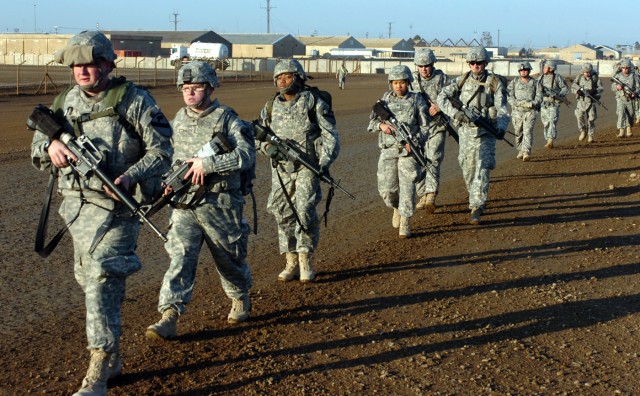CAMP TAJI-Everywhere the medics looked, another casualty was found; some missing limbs, others suffering penetrating chest wounds or head trauma.
While the injuries were simulated, the sense of urgency wasn't, as medics from 1st Air Cavalry Brigade, 1st Cavalry Division, U.S. Division-Center, frantically sought to deliver essential first aid to patients, just one part of a mass casualty exercise at the Forward Arming and Refueling Point Feb. 5.
The exercise was devised by Spc. Jennifer Sybert, from Morrisville, Vt., and a medic for 3rd Battalion, 1st ACB, who said the training was based on a presentation she created about potential mishaps at the FARP.
"This exercise demonstrates some of those mishaps, while at the same time getting the medics out of their chairs at the TMC (troop medical clinic)," Sybert said. "Having it at the FARP was intended to make it more realistic."
After a short foot march in full combat attire, the medics were put to the test by imaginary mortar rounds which had exploded at the FARP, leaving a slew of casualties, Sybert said.
"Mortar attacks are something we always have to be mindful of, so it was a good chance to have different types of casualties for a broader range of practice," Sybert explained.
Some of the injuries medics faced included burn and blast injuries from an exploded fuel truck, ranging from minor to severe.
"Considering we haven't had hands-on practice in quite a long time, our medics still remembered a remarkable amount," Sybert continued. "As with anything ... if you don't use it, you lose it."
Following initial treatment of the casualties, medics evacuated them onto waiting medevac helicopters, which Sybert said had been practiced earlier in the deployment.
"We had a full day of practicing medevac rescue back in August, so we already knew our flight medics and what we had to do," she explained. "Nobody was dropped or injured further, which was beneficial to everyone."
Many senior medics have been through training scenarios and real-life situations similar to this exercise, but medics new to the Army haven't, making it more crucial for them, Sybert said.
"For most of us at the TMC, we haven't seen anything like this, so it's not going to come to us," she said. "Unless something really goes wrong, we won't be involved in something like this."
While the training was successful as a whole, there were still things that needed improvement, said Staff Sgt. Misty Spencer, from Reno, Nev., senior medic for the 615th Aviation Support Battalion, 1st ACB.
"One of the biggest things we need to improve is our command and control," Spencer said. "We didn't have control of everything that was going on, and there wasn't one designated person in charge."
Despite the mistakes, the training was a good learning experience, she said.
"Now [the medics] realize that someone needs to be in charge," she added. "Someone needs to know what's going on, how many patients we have, who's going in the bird first, and who's calling it in."
Those involved in the exercise provided efficient aid to the casualties, with one minor discrepancy, Spencer said.
"Once they got to the patients and figured out what was wrong with them, there were no issues," she continued. "There were a few problems with the casualty collection point and where they were meeting but overall, the treatment went well."
Spencer also agreed the training was a valuable opportunity for the junior medics, who will learn from their mistakes.
"They're going to say, 'Okay, I remember this from last time and what went wrong and what we should have done,'" Spencer said. "I think that's going to kick in next time ... they really needed this experience and overall, I think it's going to benefit them."












Social Sharing